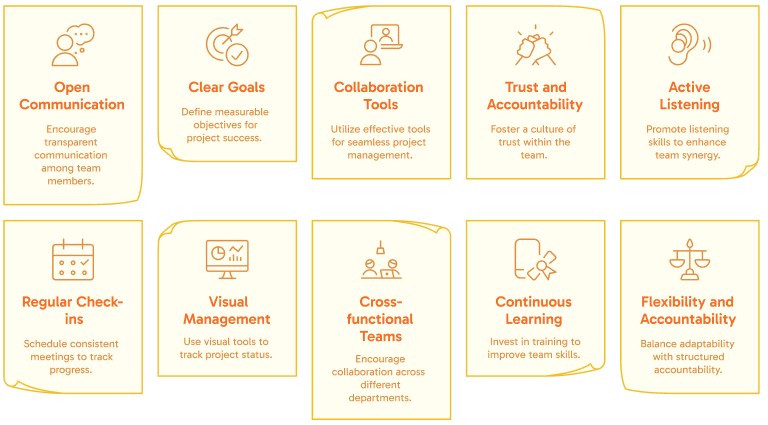project management · Apr 8, 2025
Finding Collaborative Project Management Hard? Here's What You Need to Know

Managing projects is never easy, but the challenges multiply when multiple people, departments, or even organizations need to collaborate. Tasks overlap, communication gaps emerge, and things can quickly spiral out of control without the right strategies.
Collaborative project management isn’t just about assigning tasks—it’s about ensuring that teamwork flows smoothly, ideas are shared efficiently, and goals stay aligned. Whether you're struggling with unclear responsibilities, decision-making bottlenecks, or just trying to keep everyone on the same page, this guide will help you navigate the complexities of collaborative project management.
What are Collaborative Projects
Collaborative projects bring together multiple individuals, often from different departments or even organizations, to work toward a shared goal. Unlike traditional projects, which have rigid structures and hierarchies, collaborative projects rely on teamwork, communication, and shared responsibility.
In project management, collaboration is essential for ensuring that tasks are completed efficiently and effectively. This means breaking down silos, fostering open communication, and leveraging the strengths of each team member. Collaborative projects are common in industries such as software development, marketing, research, and design, where cross-functional teamwork is crucial for success.
Types of Projects That Require Collaboration
- Marketing Campaigns – Teams consisting of content creators, designers, and analysts must work together to execute a campaign seamlessly.
- Software Development – Developers, UI/UX designers, and testers collaborate to build and refine software solutions.
- Research Projects – Researchers, data analysts, and field experts must share findings and insights in a structured way.
- Event Planning – Coordinating vendors, logistics, and marketing teams requires seamless collaboration.
- Product Development – Cross-functional teams must align efforts from ideation to production.
Managing Collaborative Projects vs. Managing Traditional Projects
Understanding the differences between managing traditional projects and collaborative projects is crucial for choosing the right approach.
Traditional Project Management
Traditional project management follows a hierarchical structure where roles and responsibilities are clearly defined. A project manager assigns tasks, sets deadlines, and ensures that each team member follows the plan. Popular methodologies such as Waterfall emphasize sequential execution, making it easier to track progress but less flexible when unexpected changes occur.
Characteristics of Traditional Project Management:
- Well-defined leadership and structure
- Fixed roles and responsibilities
- Detailed project plans with little room for deviation
- Communication primarily flows top-down
- Success is measured by adherence to the original plan
Collaborative Project Management
Collaborative project management, on the other hand, embraces flexibility and shared leadership. Team members contribute equally, communication is multidirectional, and decision-making is often a collective process. Agile and Scrum methodologies align well with collaborative project management, allowing teams to adapt quickly to changes.
Characteristics of Collaborative Project Management:
- Shared leadership and decision-making
- Dynamic roles that can shift based on project needs
- Emphasis on continuous feedback and iteration
- Open and transparent communication
- Success is measured by adaptability and teamwork
10 Tips to Improve Collaborative Project Management

To ensure the success of collaborative projects, managers must actively foster a productive and inclusive work environment. Here are ten tips to help improve collaborative project management:
1. Encourage Open Communication
Effective collaboration begins with transparent and open communication. Without clear communication channels, misunderstandings and misaligned expectations can derail collaborative projects. Teams should utilize tools like Slack, email, or Quire’s built-in messaging features to ensure a smooth flow of information. Encouraging team members to voice concerns and ask questions fosters an environment where problems are addressed early, preventing costly delays or conflicts down the line.
2. Define Goals and Expectations Clearly
A lack of clear objectives can cause confusion and inefficiency. Collaborative projects involve multiple stakeholders, and without a shared understanding of what success looks like, teams may work in different directions. Setting measurable and achievable goals—such as defining product milestones or specific KPIs—keeps everyone aligned. When expectations are transparent, accountability increases, and team members are more likely to take ownership of their tasks.
3. Use the Right Collaboration Tools
Managing a collaborative project without the right tools leads to inefficiencies and communication breakdowns. Platforms like Quire provide task tracking, real-time updates, and seamless integrations, enabling teams to coordinate work effortlessly. With features like shared workspaces and automated notifications, project members stay updated on progress, reducing the need for back-and-forth emails and status meetings. The right tools bridge the gap between teams working remotely or across different departments.
4. Foster a Culture of Trust and Accountability
Collaboration fails when team members do not trust one another or feel hesitant to take responsibility. A culture of accountability ensures that everyone understands their role and delivers on commitments. Managers should lead by example, recognizing efforts and reinforcing trust through transparent decision-making. When trust is established, collaboration becomes more efficient, as team members feel comfortable relying on one another and proactively resolving challenges.
5. Promote Active Listening
Successful collaborative project management requires more than just speaking—it demands listening. When team members do not actively listen, misunderstandings arise, and crucial details may be overlooked. Encouraging active listening in meetings and discussions ensures that ideas are acknowledged and feedback is constructive. This practice not only enhances team synergy but also prevents misinterpretations that could lead to project setbacks.
6. Set Regular Check-ins and Stand-up Meetings
Without structured check-ins, collaborative projects risk going off track. Daily or weekly meetings help teams stay informed about progress, roadblocks, and upcoming deadlines. Agile-style stand-up meetings allow teams to quickly identify challenges and course-correct before minor issues escalate into major setbacks. Consistent check-ins foster transparency, keeping all stakeholders engaged and aligned with project goals.
7. Leverage Visual Project Management Techniques
Tracking progress through spreadsheets or scattered notes can lead to inefficiencies. Visual tools like Kanban boards, Gantt charts, and roadmaps provide a clear overview of task status, dependencies, and milestones. When teams can visualize workloads, bottlenecks become easier to identify, and progress tracking becomes more intuitive. Tools like Quire’s timeline view help teams maintain focus and ensure projects move forward efficiently.
8. Encourage Cross-functional Collaboration
Siloed teams hinder innovation and delay project execution. When departments like marketing and product development collaborate, they bring different perspectives and expertise to the table, fostering the exchange of ideas that might not emerge in isolation.
For example, marketing teams can provide insights into customer needs, while product developers translate those insights into innovative features. This cross-functional interaction leads to well-rounded solutions and more effective execution.
Breaking down communication barriers ensures knowledge is shared efficiently, and using a project management tool keeps collaboration structured and transparent.
9. Emphasize Continuous Learning
Collaborative projects thrive when team members constantly refine their skills and knowledge. Without ongoing learning, teams may struggle to adapt to new challenges. Organizations should invest in training sessions, knowledge-sharing workshops, and mentorship programs to help employees improve their collaborative abilities. When teams prioritize learning, they become more adaptable, innovative, and effective in managing projects together.
10. Balance Flexibility with Accountability
While collaboration encourages adaptability, projects can easily go off track without a structured approach. A balance must be struck between allowing flexibility for creative problem-solving and ensuring that deadlines are met. Establishing clear accountability structures, monitoring progress through project management tools, and setting realistic deadlines help teams maintain productivity while still fostering an open, creative work environment.
By implementing these strategies, teams can enhance collaboration, prevent common pitfalls, and achieve greater efficiency in project execution. Tools like Quire provide the necessary framework to streamline workflows, improve transparency, and ensure that every team member contributes effectively to the project’s success.
Problems to Avoid in Collaborative Project Management
While collaborative projects offer many benefits, they also present challenges. Here are some common issues and how to overcome them:
- Poor Communication – Effective collaboration hinges on clear and timely communication. When updates are scattered across multiple channels or expectations are ambiguous, teams risk misunderstandings, missed deadlines, and reduced accountability. In collaborative projects, this can cause serious delays and conflicts. To address this, establish communication norms, use centralized communication platforms, and schedule regular check-ins. Quire integrates messaging within task management, ensuring that discussions remain contextual and accessible to all relevant stakeholders.
- Unclear Roles and Responsibilities – Collaboration can become chaotic when team members are unsure of their roles. This often results in duplicated work, delays, or important tasks falling through the cracks. In a collaborative project, clearly defined roles ensure accountability and efficiency. At the project's start, outline each team member’s responsibilities and document them within a project management tool. With Quire, you can assign tasks, set priorities, and track progress, ensuring that everyone knows their responsibilities.
- Decision-making Bottlenecks – In collaborative teams, involving multiple stakeholders in decision-making can slow down progress, leading to project stagnation. When decision-making processes are unclear, teams may waste time waiting for approvals or resolving conflicts. To streamline this, define a clear decision-making framework, assign decision-makers for different aspects of the project, and set deadlines for approvals. Quire allows teams to structure workflows with approval processes, keeping projects moving efficiently.
- Choosing the Wrong Collaboration Tools – Not all collaboration tools fit every project. A tool that lacks flexibility or fails to integrate with your team’s workflow can hinder rather than enhance productivity. Before selecting a platform, assess your team’s needs—consider aspects like task tracking, communication, and integration with existing tools. Quire’s flexibility, real-time collaboration features, and visual workflow options make it an ideal choice for collaborative project management.
- Lack of Team Engagement – If team members feel disconnected or undervalued, motivation and productivity decline, affecting the success of a collaborative project. Teams that lack engagement struggle with participation, accountability, and creativity. To foster engagement, recognize contributions, offer opportunities for professional growth, and create an inclusive work environment. With Quire, you can celebrate milestones, track team progress, and ensure that every team member has a voice, leading to a more motivated and aligned team.
Recommended Collaborative Project Management Tools
Using the right tools can make or break a collaborative project. Here are some of the best tools for managing teamwork efficiently:
Quire: The Ultimate Collaborative Project Management Tool
Quire is an intuitive project management platform designed to simplify collaborative work. It offers:
- Nested Task Lists – Break complex projects into manageable steps.
- Kanban Boards – Visualize progress and streamline workflow.
- Real-time Collaboration – Keep everyone on the same page with instant updates.
- Integration with Google Calendar & Other Apps – Sync tasks seamlessly.
- Smart Notifications – Stay updated without overwhelming distractions.
Other Useful Tools
- Slack – Ideal for real-time communication.
- Trello – Good for simple task tracking.
- Asana – Offers structured project planning features.
- Google Drive – Ensures easy document sharing and collaboration.
By leveraging the right strategies and tools like Quire, managing collaborative projects becomes much easier. Whether you're coordinating a marketing campaign, developing a new product, or managing a research initiative, the key lies in fostering transparency, flexibility, and teamwork.

